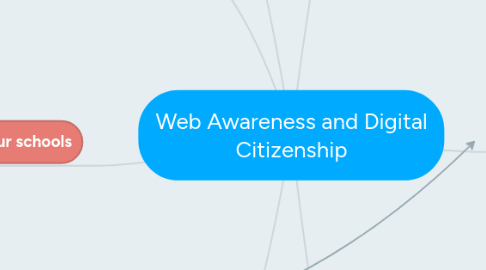
1. Rules of Digital Citizenship
1.1. Respect for Self
1.2. Respect for Others
1.3. Respect for Intellectual Property
1.4. Balancing personal empowerment with community well-being
1.5. 9 Elements http://www.digitalcitizenship.net/Nine_Elements.html
2. How to Teach
2.1. Common Sense Program
2.1.1. Indentity
2.1.2. Privacy
2.1.3. Ownership
2.1.4. Trustworthiness
2.1.5. Participation
2.1.6. https://www.commonsensemedia.org/educators/curriculum
2.2. Read book Digital Community, Digital Citizen by Jason Ohler (2010)
2.3. Class Projects /Activities
2.3.1. Fakebook profile
2.3.2. Chart levels of harm
2.3.3. Review fake profiles with a discerning eye
2.3.4. 3 Facts, 1 Fiction not face-to-face
2.4. Create an ethical core
2.5. Have students share experiences on the internet
2.5.1. Helps teacher's know what to teach
2.5.2. Helps them be aware of what they are doing online
2.6. "Think before you click!"
2.7. Resources
2.7.1. http://www.2learn.ca/ydp/default.aspx
2.7.2. https://education.alberta.ca/media/7533793/digitalcitizenshiptechbriefing.pdf
2.7.3. Bullying: http://www.prevnet.ca/
2.7.4. http://www.digitalcitizenship.net/Nine_Elements.html
2.7.5. Brain Pop Netiquette https://www.brainpop.com/technology/digitalcitizenship/digitaletiquette/
2.7.6. GAMES! http://mediasmarts.ca/digital-media-literacy/educational-games
2.7.7. MediaSmart - fantastic resource, so many teaching options.
3. Challenges
3.1. Technology changing at a rapid pace
3.1.1. Must respond quickly to new developments
3.2. Changing children's role in digital literacy from consumer to creator/disseminator
3.3. Balancing open online learning with student safety
3.4. CyberBullying http://bullying.org/
3.5. Sexually Explicit Material https://www.kidsintheknow.ca/pdfs/KIK_ImpactOfViewing_en.pdf
4. Digital Presence
4.1. Formed by self and others
4.2. Added to by self
4.2.1. Positively
4.2.2. Negatively
4.3. Added to by others
4.3.1. Positively
4.3.2. Negatively
4.3.3. With permission
4.3.4. Without permission
5. Students Need to Be...
5.1. Ethical
5.2. Engaged thinkers
5.3. Creators/disseminators of info
5.4. Critical thinkers to protect themselves and others online.
6. How to incorporate in our schools
6.1. Consider key questions with school authority
6.1.1. See https://education.alberta.ca/media/7533793/digitalcitizenshiptechbriefing.pdf
6.1.2. Consider using Digital Citizenship Needs Assessment Tool Digital (at above site)
6.1.3. Studies from MediaSmarts http://mediasmarts.ca/research-policy
6.2. https://education.alberta.ca/media/6735100/digital%20citizenship%20policy%20development%20guide.pdf
6.3. Know your students
6.3.1. Studies from MediaSmarts http://mediasmarts.ca/research-policy
6.3.2. Student Statistics
6.3.2.1. http://mediasmarts.ca/sites/mediasmarts/files/images/publication-report/infographic-YCWWIII-Life-Online.pdf
6.4. Teach!
7. Main Issues to Address
7.1. Authenticity
7.1.1. Great checklist! http://www.lib.vt.edu/instruct/evaluate/
7.2. Marketing to Children
7.2.1. http://mediasmarts.ca/marketing-consumerism/how-marketers-target-kids
7.2.2. file:///Users/carter/Downloads/csm-advertisingresearchbrief-20141.pdf
7.2.3. http://mediasmarts.ca/privacy/advertising-marketing-consumerism-children-youth-online
7.3. Privacy
7.3.1. Students' Guide to Personal Publishing http://people.uwec.edu/patchinj/cyberbullying/students_guide_to_personal_publishing.pdf
7.3.2. Scary but powerful video: https://www.youtube.com/watch?v=F7pYHN9iC9I
7.4. Copyright
7.4.1. Great resource for educators from Media Smarts http://mediasmarts.ca/digital-media-literacy/media-issues/intellectual-property/fair-dealing-media-education
7.4.2. CBC article http://www.cbc.ca/news2/background/internet/copyright.html
7.4.3. http://newmediacreation.weebly.com/copyright.html

